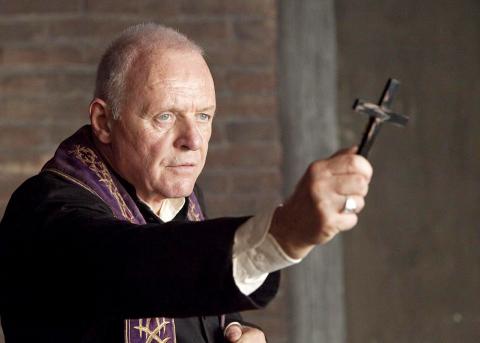“What did you expect? Spinning heads? Pea soup?” Father Lucas Trevant (Anthony Hopkins), a Jesuit who has performed thousands of exorcisms, inquires sarcastically of Michael Kovak (Colin O’Donoghue), an earnest young American seminarian in The Rite.
As the son of an undertaker preparing for the priesthood, Michael is familiar with gruesome evisceration. In the throes of a spiritual crisis that threatens his faith, he has traveled to the Vatican, where he is dispatched by the sinister, glowering Father Xavier (Ciaran Hinds) to witness Father Lucas practice his brand of hocus-pocus. Father Lucas’ current subject, Rosaria (Marta Gastini), is a pregnant 16-year-old who has been raped by her father and exhibits signs of demonic possession. Contorting her body, raking her fingernails against the wall, the poor girl, if you’ll pardon the joke, is going through hell.
Michael is certain that her symptoms, no matter how alarming, must have a medical explanation. Is it the devil’s work or a psychiatric disorder? That is the spurious debate that sputters along in this dull, pretentiously verbose movie that (need it be said?) enthusiastically takes the devil’s side.

Photo Courtesy of Warner Bros
This supernatural thriller — suggested by Matt Baglio’s book, The Rite: The Making of a Modern Exorcist, and directed by Mikael Hafstrom (1408, Derailed) from a screenplay by Michael Petroni (The Chronicles of Narnia: The Voyage of the Dawn Treader) — is billed as having been inspired by true events. Without head spinning and bilious regurgitation, The Rite is a workmanlike B-movie that embraces as many of the genre’s cliches as a PG 13-rating allows.
The demonic voice that growls from within Rosaria is not as frightening nor is its language as colorful as Mercedes McCambridge’s effusions in The Exorcist, this subgenre’s flamboyant granddaddy, now going on 38 years old. As for those cliches: It rains heavily much of the time, and rumbles of thunder signal the devil’s proximity. So do the yowls of stray cats in Father Lucas’ yard. There is an infestation of tiny chirping frogs, and a mule with red eyes materializes from of one of Michael’s nightmares.
Most important, nobody, but nobody, cracks the semblance of a smile unless it is a Mephistophelean grin. Why? Because life is very, very serious, and evil is too prevalent for there to be room for laughter, pleasure, enjoyment or humor of any kind. The predominant facial expression is a suspicious, paranoid acknowledgment of universal complicity in diabolical evil. The Rite fruitlessly throws in a non-love interest in Angeline (Alice Braga), a glum reporter who witnesses the strange goings-on and is impressed.
At least you can count on Hopkins, whose Father Lucas is eventually possessed by the devil, to deliver an expertly hammy variation on his Silence of the Lambs performance. Even when playing virtuous characters, Hopkins conveys an insinuating ambiguity. It’s in his too-mellifluous voice, his too-cognizant gaze, his jack-o’-lantern smirk. Under the devil’s spell his face suggests a Jared L. Loughner mug shot 50 years down the line. Study it long enough, and you might turn to stone.

In the March 9 edition of the Taipei Times a piece by Ninon Godefroy ran with the headine “The quiet, gentle rhythm of Taiwan.” It started with the line “Taiwan is a small, humble place. There is no Eiffel Tower, no pyramids — no singular attraction that draws the world’s attention.” I laughed out loud at that. This was out of no disrespect for the author or the piece, which made some interesting analogies and good points about how both Din Tai Fung’s and Taiwan Semiconductor Manufacturing Co’s (TSMC, 台積電) meticulous attention to detail and quality are not quite up to

April 21 to April 27 Hsieh Er’s (謝娥) political fortunes were rising fast after she got out of jail and joined the Chinese Nationalist Party (KMT) in December 1945. Not only did she hold key positions in various committees, she was elected the only woman on the Taipei City Council and headed to Nanjing in 1946 as the sole Taiwanese female representative to the National Constituent Assembly. With the support of first lady Soong May-ling (宋美齡), she started the Taipei Women’s Association and Taiwan Provincial Women’s Association, where she

It is one of the more remarkable facts of Taiwan history that it was never occupied or claimed by any of the numerous kingdoms of southern China — Han or otherwise — that lay just across the water from it. None of their brilliant ministers ever discovered that Taiwan was a “core interest” of the state whose annexation was “inevitable.” As Paul Kua notes in an excellent monograph laying out how the Portuguese gave Taiwan the name “Formosa,” the first Europeans to express an interest in occupying Taiwan were the Spanish. Tonio Andrade in his seminal work, How Taiwan Became Chinese,

Mongolian influencer Anudari Daarya looks effortlessly glamorous and carefree in her social media posts — but the classically trained pianist’s road to acceptance as a transgender artist has been anything but easy. She is one of a growing number of Mongolian LGBTQ youth challenging stereotypes and fighting for acceptance through media representation in the socially conservative country. LGBTQ Mongolians often hide their identities from their employers and colleagues for fear of discrimination, with a survey by the non-profit LGBT Centre Mongolia showing that only 20 percent of people felt comfortable coming out at work. Daarya, 25, said she has faced discrimination since she